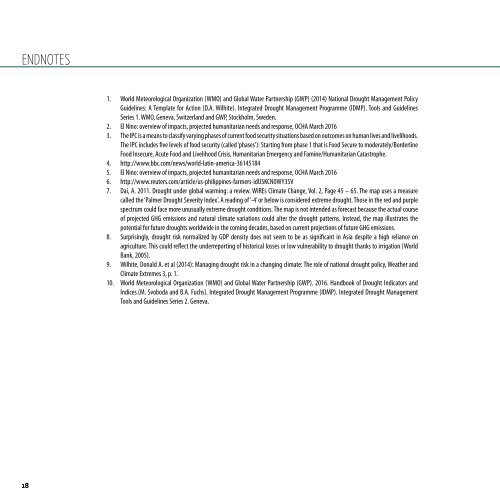The Ripple Effect
2016_Drought_ENG
2016_Drought_ENG
You also want an ePaper? Increase the reach of your titles
YUMPU automatically turns print PDFs into web optimized ePapers that Google loves.
Endnotes<br />
1. World Meteorological Organization (WMO) and Global Water Partnership (GWP) (2014) National Drought Management Policy<br />
Guidelines: A Template for Action (D.A. Wilhite). Integrated Drought Management Programme (IDMP). Tools and Guidelines<br />
Series 1. WMO, Geneva, Switzerland and GWP, Stockholm, Sweden.<br />
2. El Nino: overview of impacts, projected humanitarian needs and response, OCHA March 2016<br />
3. <strong>The</strong> IPC is a means to classify varying phases of current food security situations based on outcomes on human lives and livelihoods.<br />
<strong>The</strong> IPC includes five levels of food security (called ‘phases’): Starting from phase 1 that is Food Secure to moderately/Borderline<br />
Food Insecure, Acute Food and Livelihood Crisis, Humanitarian Emergency and Famine/Humanitarian Catastrophe.<br />
4. http://www.bbc.com/news/world-latin-america-36145184<br />
5. El Nino: overview of impacts, projected humanitarian needs and response, OCHA March 2016<br />
6. http://www.reuters.com/article/us-philippines-farmers-idUSKCN0WY3SV<br />
7. Dai, A. 2011. Drought under global warming: a review. WIREs Climate Change, Vol. 2, Page 45 – 65. <strong>The</strong> map uses a measure<br />
called the ‘Palmer Drought Severity Index’. A reading of ‘-4’ or below is considered extreme drought. Those in the red and purple<br />
spectrum could face more unusually extreme drought conditions. <strong>The</strong> map is not intended as forecast because the actual course<br />
of projected GHG emissions and natural climate variations could alter the drought patterns. Instead, the map illustrates the<br />
potential for future droughts worldwide in the coming decades, based on current projections of future GHG emissions.<br />
8. Surprisingly, drought risk normalized by GDP density does not seem to be as significant in Asia despite a high reliance on<br />
agriculture. This could reflect the underreporting of historical losses or low vulnerability to drought thanks to irrigation (World<br />
Bank, 2005).<br />
9. Wilhite, Donald A. et al (2014): Managing drought risk in a changing climate: <strong>The</strong> role of national drought policy, Weather and<br />
Climate Extremes 3, p. 1.<br />
10. World Meteorological Organization (WMO) and Global Water Partnership (GWP). 2016. Handbook of Drought Indicators and<br />
Indices.(M. Svoboda and B.A. Fuchs). Integrated Drought Management Programme (IDMP). Integrated Drought Management<br />
Tools and Guidelines Series 2. Geneva.<br />
18


